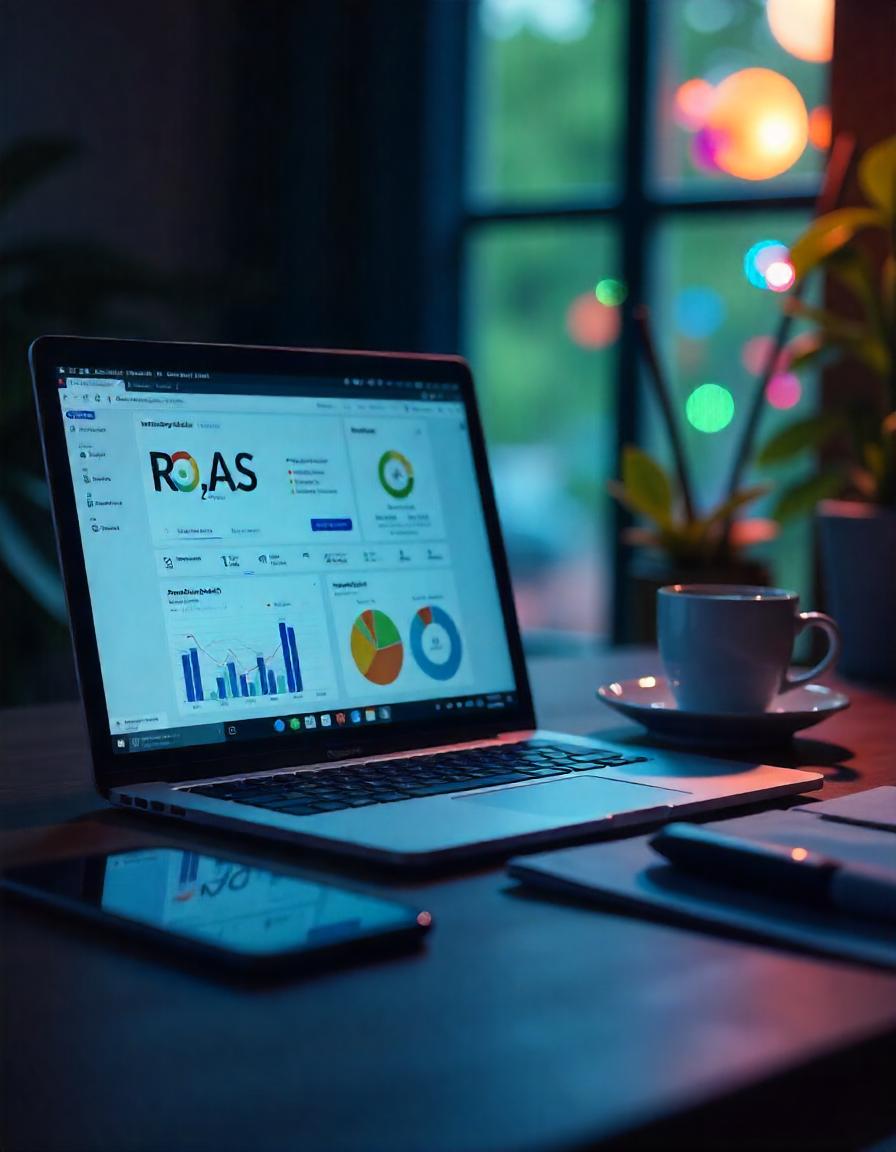ROAS Calculator
Calculate your Return on Ad Spend in real-time
Your ROAS
Net Profit
$0.00ROI
0.00%CPA
$0.00Return on Ad Spend (ROAS) is a marketing metric that measures the revenue generated for every dollar spent on advertising.
The formula is: ROAS = Revenue from Ads / Cost of Ads
- A ROAS of 1 means you’re breaking even
- A ROAS greater than 1 means you’re profitable
- A ROAS less than 1 means you’re losing money
Most businesses aim for a ROAS of at least 4:1 ($4 revenue for every $1 spent).
Compare with Industry Averages
Discover how to use a ROAS calculator to boost your marketing ROI. Easy steps, expert tips, and free tools inside.
The Ultimate Guide to Using a ROAS Calculator for Smarter Marketing

Hey there, fellow marketer! 👋 Ever poured money into ads and felt unsure if it actually paid off? Well, you’re not alone. That’s exactly why ROAS (Return on Ad Spend) is such a game-changer.
Imagine having a magic lens that tells you, “Hey! For every $1 you spend, you’re making $3 back.” That’s what ROAS does. It’s like your profit compass in the vast ocean of online marketing.
In this guide, we’re breaking everything down in the simplest, friendliest way possible. Whether you’re a business owner, a digital ad wizard, or just starting out in eCommerce — this is your go-to playbook. So grab your coffee ☕, and let’s decode the math that drives millions in revenue.
🧮 What is ROAS?
ROAS stands for Return on Ad Spend. It tells you how much revenue you earn for every dollar you spend on advertising.
Simple ROAS formula:
ROAS = Revenue from Ads / Cost of Ads
So, if you made $500 from a campaign that cost you $100, your ROAS is:
500 / 100 = 5 (or 500%)
This means for every $1 you spent, you made $5. Not bad, huh?
🚀 Why ROAS Matters More Than You Think
Think of ROAS as your business’s fitness tracker. It shows you what’s working, what’s wasting cash, and where to double down.
Here’s why it’s gold:
- Tracks ad efficiency like a hawk 🦅
- Helps you budget smarter
- Guides your campaign tweaks
- Tells you when to scale or pause
Let’s be honest—without tracking ROAS, you're pretty much guessing. And that’s not how you win in digital marketing.
📐 The ROAS Formula Explained
Let’s get our hands dirty with the math (don’t worry, it’s easier than algebra).
The Basic Formula:
ROAS = Revenue Generated from Ads / Cost of Ads
Both numbers should cover the same timeframe and platform (like your Facebook ads last month, or your Google Ads for Q1).
Real-World ROAS Example
Imagine you run a T-shirt brand and spend $2,000 on Instagram ads. Those ads bring in $8,000 in sales.
Your ROAS is:
8000 / 2000 = 4 (or 400%)
For every $1, you’re getting $4 back.
That’s the kind of math we LOVE. 💸
⚔️ ROAS vs ROI: Know the Difference
Hold up—aren’t ROAS and ROI the same thing? Not exactly.
Here’s a quick comparison:
| Metric | Stands for | Focuses On | Includes Costs? |
| ROAS | Return on Ad Spend | Revenue from ads | Only ad costs |
| ROI | Return on Investment | Total profit | Includes all costs (like product cost, salaries, etc.) |
Think of ROAS as just one slice of the bigger ROI pie. 🍰
🧾 How to Calculate ROAS – Step by Step
Manual Method
All you need is:
- Total Revenue from your campaign
- Total Ad Spend
Then plug it into the formula:
ROAS = Total Revenue / Ad SpendFor example:
- Revenue: $6,000
- Ad Spend: $2,000
ROAS = 6000 / 2000 = 3.0 (or 300%) ✅
Using an Online ROAS Calculator
Don’t like math? No problem! Use tools like:
- Shopify’s free ROAS calculator
- Neil Patel’s Ad ROI calculator
- Facebook Ad Manager (includes ROAS in campaign reports)
Just enter your revenue and cost, and boom—you’ve got your result.

🛠️ Tools to Calculate ROAS Instantly
Google Ads ROAS Tool
Google Ads gives you ROAS in your campaign performance dashboard. Go to “Campaigns” → check “Conv. value / cost”. That’s your ROAS.
Facebook Ads ROAS Tracker
In Facebook Business Manager:
- Navigate to Ads Manager
- Customize columns → Add “Purchase ROAS”
Now you’re tracking returns like a pro. 💼
🎯 What’s a Good ROAS?
It depends on your margins, but generally:
| ROAS | Meaning |
| <1.0 | Losing money 😬 |
| 1.0 | Breaking even |
| 2.0–4.0 | Good range for most businesses |
| 4.0+ | Excellent performance 💪 |
High-ticket items can afford lower ROAS. For low-margin products, you’ll need a higher ROAS to profit.
🔧 How to Improve Your ROAS
Optimize Your Ad Creatives
Make eye-catching visuals. Write copy that sells. Test headlines, colors, layouts — the works.
Target the Right Audience
Stop wasting budget on cold leads. Use lookalike audiences, retargeting, and interest-based filters.
Improve Landing Page Conversion
Your ad worked. Great. Now don’t lose them on a slow, clunky page. Optimize it with:
- Clear CTAs
- Fast loading
- Trust signals
- Mobile responsiveness
❌ Common ROAS Mistakes to Avoid
- Ignoring timeframes (daily vs monthly ROAS)
- Not including refunds or cancellations
- Focusing only on last-click attribution
- Comparing cross-channel ROAS unfairly
🏭 ROAS for Different Industries
eCommerce
High-volume, high-competition. Aim for 3.0+ to survive and thrive.
SaaS Companies
Longer sales cycles. ROAS might be lower short-term but grows over lifetime value (LTV).
Local Businesses
Smaller budgets. Focus on geo-targeting and track leads accurately.
🧨 ROAS Myths Busted
- “High ROAS = High Profits” — Not always if margins are low.
- “ROAS is enough” — You still need to track CAC, LTV, and profit.
- “Google ROAS = Facebook ROAS” — Platforms behave differently. Always segment your tracking.
🎯 How to Set ROAS Goals
Start with your break-even ROAS. Then:
- Calculate profit margins
- Factor in fixed costs
- Add desired profit
Example: if you have a 25% margin, break-even ROAS is 4.0. Want 50% profit? Aim for 6.0.
💻 ROAS Calculator Code Example (Bonus for Developers)
Here’s a simple ROAS calculator in HTML + JavaScript:
<input type="number" id="revenue" placeholder="Enter Revenue">
<input type="number" id="cost" placeholder="Enter Ad Cost">
<button onclick="calcROAS()">Calculate ROAS</button>
<p id="result"></p>
<script>
function calcROAS() {
const revenue = parseFloat(document.getElementById("revenue").value);
const cost = parseFloat(document.getElementById("cost").value);
const roas = revenue / cost;
document.getElementById("result").innerText = "Your ROAS is: " + roas.toFixed(2);
}
</script>🆓 Best Free ROAS Calculators Online
- Shopify ROAS Calculator
- Neil Patel’s Marketing ROI Tool
- BigCommerce ROAS Estimator
- Ahrefs’ Ad Calculator
- WebFX Free Calculator
🧠 Final Thoughts
ROAS is more than just a number — it’s your growth compass. Master it, and you’ll make smarter ad decisions, scale confidently, and stop burning cash on low-performing campaigns.
Don’t guess. Calculate. Optimize. Profit. 🚀
🧮 How to Calculate ROAS – Step by Step
Understanding ROAS starts with getting your hands a little dirty—either with a calculator or with a helpful tool. Here's how to calculate it like a pro.
✍️ Manual Method
If you're someone who loves spreadsheets or just wants to understand the nuts and bolts, here's how you do it manually.
- Track Your Ad Spend
Look at how much you spent on a particular campaign or channel (e.g., Facebook Ads, Google Ads). - Measure Revenue from Ads
Only include the revenue directly tied to that campaign—like purchases from clicks on that ad. - Plug into the Formula
ROAS = Revenue from Ads / Cost of Ads
📌 Example:
- Cost of Ads: $1,200
- Revenue Generated: $6,000
ROAS = 6000 / 1200 = 5
This means you’re earning $5 for every $1 spent. Solid return!

⚡ Using an Online ROAS Calculator
Not a fan of math? No problem. There are tons of free ROAS calculators online that do the job instantly. Here’s how to use them:
- Find a Calculator
Use tools like the Google Ads Performance Planner or search “Free ROAS Calculator.” - Enter Your Ad Spend
Input the amount you spent on ads for a campaign. - Enter Revenue
Add the revenue generated directly from that campaign. - Boom! See Your ROAS
The tool will automatically show you your return on ad spend.
These calculators save time, reduce human error, and help you focus on improving rather than just calculating.
🔧 Tools to Calculate ROAS Instantly
If you're looking for speed and simplicity, these tools are your new best friends.
1. Google Ads ROAS Tool
Google Ads comes with a built-in performance planner that helps you:
- Predict ROAS for campaigns.
- Set target ROAS bidding strategies.
- View how changes in spend impact your return.
💡 Great for: eCommerce brands, SaaS companies running search/display campaigns.
2. Facebook Ads ROAS Tracker
Facebook Ads Manager shows ROAS data right in your dashboard. With proper conversion tracking (via the Meta Pixel), you’ll get:
- Real-time ROAS metrics.
- Insights per ad, ad set, or campaign.
- Automated rules to pause low-ROAS ads.
💡 Great for: Brands with visual products, influencers, or high-volume advertisers.
3. Shopify + Google Analytics
Running an eCommerce store? You can combine Shopify’s sales data with Google Analytics tracking to get precise ROAS for each marketing channel.
💡 Great for: Store owners, dropshippers, and DTC businesses.
4. Third-Party Tools (e.g., Triple Whale, Hyros, Northbeam)
These offer advanced attribution and track ROAS across multiple platforms. They:
- Unify ad spend and revenue sources.
- Account for delayed conversions.
- Provide better cross-channel ROAS insights.
💡 Great for: Businesses spending $10K+/month on ads or scaling fast.
❓ FAQs
1. What is a good ROAS for Facebook Ads?
Typically 2.0 to 4.0 is solid. But aim higher if your margins allow.
2. How do I calculate ROAS on Amazon?
Use your ad dashboard to find total revenue and ad spend. Then plug it into the ROAS formula.
3. Is ROAS better than ROI?
They serve different purposes. ROAS is great for ad-specific decisions. ROI is broader and includes all business costs.
4. What’s the difference between ROAS and CAC?
CAC is Customer Acquisition Cost. ROAS is revenue from those acquired. Both matter!
5. Can I use ROAS for organic content?
Nope. ROAS only works for paid advertising since it depends on ad spend.
